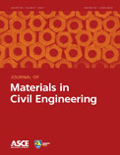
JOURNAL OF MATERIALS IN CIVIL ENGINEERING
Scope & Guideline
Transforming Ideas into Engineering Solutions
Introduction
Aims and Scopes
- Material Durability and Performance:
Research on the long-term durability and performance of construction materials, including studies on corrosion resistance, aging mechanisms, and environmental impacts on material integrity. - Sustainability and Recycling:
Focus on sustainable practices in civil engineering, including the use of recycled materials, waste utilization, and the development of eco-friendly construction materials. - Mechanical and Physical Properties of Materials:
Investigation into the mechanical, thermal, and rheological properties of various construction materials, including concrete, asphalt, and composites, to enhance performance and application. - Innovative Material Technologies:
Research on new materials and technologies in civil engineering, including advanced composites, nanomaterials, and bio-based materials, aimed at improving the efficiency and sustainability of construction. - Geotechnical Engineering Applications:
Studies addressing the interaction of materials with soil and rock, including stabilization techniques, waste management in geotechnical applications, and the performance of geosynthetics. - Structural Performance and Design:
Research on the behavior of materials in structural applications, including load-bearing capacities, dynamic responses, and fracture mechanics.
Trending and Emerging
- Bio-Inspired and Self-Healing Materials:
Research on bio-inspired materials and self-healing technologies is on the rise, focusing on the development of materials that can autonomously repair damage, significantly enhancing longevity and sustainability. - Nanotechnology in Construction Materials:
The integration of nanotechnology in construction materials is increasingly prevalent, with studies exploring how nanoscale modifications can improve material properties, durability, and performance. - Smart Materials and Sensors:
There is a growing interest in smart materials that incorporate sensing capabilities for monitoring structural health, enabling real-time feedback and maintenance strategies. - Climate-Resilient Materials:
Research focusing on the development of materials designed to withstand extreme climate conditions is trending, reflecting the need for infrastructure that can endure environmental challenges. - Recycling and Circular Economy Practices:
Emphasis on recycling practices and the circular economy within civil engineering is gaining traction, with studies exploring the use of waste materials and sustainable practices in construction. - Advanced Composite Materials:
The use of advanced composite materials, including fiber-reinforced and polymer-based composites, is increasingly explored for their superior mechanical properties and applications in innovative structural solutions.
Declining or Waning
- Traditional Concrete Mix Designs:
Research focused solely on traditional concrete mix designs without innovative additives or alternative materials has seen a decline, as the field increasingly emphasizes sustainability and performance enhancement. - Conventional Asphalt Technologies:
Studies centered on conventional asphalt mixtures and their properties without considering modern modifications or recycled materials are becoming less prominent, as there is a shift towards more sustainable and innovative asphalt solutions. - Basic Material Testing Methods:
Papers that discuss only fundamental material testing methods without integrating advanced analytical techniques or new materials have decreased, indicating a move towards more sophisticated methodologies. - Non-Composite Materials:
Research on non-composite materials is waning as the field shifts focus towards composite and hybrid materials that offer better performance and sustainability. - Generalized Failure Mechanisms:
Studies that provide generalized descriptions of failure mechanisms without context-specific applications or material innovations are less frequent, as researchers seek more detailed and applicable findings.
Similar Journals

Teknik Dergi
Pioneering Insights for Structural ExcellenceTeknik Dergi is a key academic journal published by the Turkish Chamber of Civil Engineers, focusing on the critical fields of Building and Construction as well as Civil and Structural Engineering. Established in Turkey, this journal serves as a vital platform for researchers, practitioners, and students to disseminate innovative findings and advancements within these disciplines. Although its coverage in databases like Scopus has been discontinued since 2022, Teknik Dergi remains a respected resource for its historical contributions, with a record of publication spanning from 1990 to 1998 and then from 2002 to 2022. The journal currently holds a Q4 categorization in both its primary fields, ranking within the 30th and 25th percentiles respectively. Authors and readers can access articles exploring practical applications and theoretical foundations, making it a valuable asset for those engaged in the rapidly evolving landscape of civil engineering. Open Access options are also available, allowing for broader dissemination and engagement with its published work.
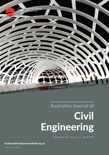
Australian Journal of Civil Engineering
Transforming Ideas into Engineering ExcellenceThe Australian Journal of Civil Engineering, published by Taylor & Francis Ltd, stands as a pivotal platform within the field of civil and structural engineering. With an ISSN of 1448-8353 and an E-ISSN of 2204-2245, this journal consistently delivers high-quality research and innovative practices from both established and emerging scholars in the discipline. Recognized in the Q2 category for Civil and Structural Engineering in 2023, it holds a respectable position, ranking 146 out of 379 within its field according to Scopus, which places it in the 61st percentile. Converging valuable insights from 2011 through 2024, the journal encompasses a broad scope of topics, including sustainable infrastructure, innovative materials, and advanced construction techniques, thereby addressing contemporary challenges faced by engineering professionals. Though it is a traditional publication without open access options, the quality of the research featured ensures that it remains an essential resource for academics, practitioners, and students striving to enhance their knowledge and contribute to the dynamic field of civil engineering.

World Journal of Engineering
Pioneering Insights Across Diverse Engineering DisciplinesWorld Journal of Engineering, published by EMERALD GROUP PUBLISHING LTD, stands as a premier platform for disseminating high-quality research across various engineering disciplines. Since its inception in 2014, the journal has built a reputation for its rigorous peer-review process and commitment to advancing knowledge in the fields of Civil and Structural Engineering, Electrical and Electronic Engineering, Geotechnical Engineering, Mechanical Engineering, and Mechanics of Materials. With its categorization in the Q3 quartile across multiple engineering domains and notable Scopus rankings, the journal positions itself as a valuable resource for researchers, professionals, and students seeking to stay abreast of innovations and critical developments in engineering. While the journal currently operates under a subscription model, its comprehensive scope ensures that it remains a vital reference point for contemporary engineering challenges and solutions throughout the United Kingdom and beyond.

Periodica Polytechnica-Civil Engineering
Exploring the Frontiers of Civil Engineering ResearchPeriodica Polytechnica-Civil Engineering is a prestigious journal published by the Budapest University of Technology and Economics, dedicated to advancing the field of civil engineering through high-quality research and innovative practices. Established in 1972, the journal has transitioned through various phases of publication and now spans an expansive range of topics within civil and structural engineering, geotechnical engineering, and engineering geology. With an impact factor indicating its growing influence and a commendable placement in the Q3 quartile according to the latest 2023 metrics, it recognizes contributions that bridge theoretical advancements with practical applications. While currently not open access, the journal remains a vital resource for researchers, professionals, and students seeking to stay abreast of the latest developments in engineering design, construction techniques, and geotechnical innovations. The continuous publication of significant research after almost five decades underscores its commitment to disseminating knowledge crucial for the world’s infrastructure challenges, making it an essential reference point within the engineering community.
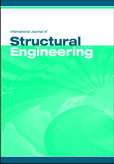
International Journal of Structural Engineering
Pioneering Insights in Civil and Structural EngineeringInternational Journal of Structural Engineering, published by InderScience Enterprises Ltd, has established itself as a vital resource in the field of civil and structural engineering. With an ISSN of 1758-7328 and an E-ISSN of 1758-7336, this journal is dedicated to disseminating high-quality research that addresses contemporary challenges and innovations in structural engineering. The journal operates under a rigorous peer-review process, ensuring that only the most impactful and relevant studies are shared with the global community. Since its inception in 2009, the journal has been recognized for its contributions, earning a ranking in Q3 for civil and structural engineering under the 2023 Category Quartiles and occupying the 40th percentile in Scopus rankings. While currently not an open-access journal, it provides access to a wide array of original papers, reviews, and case studies that are crucial for fostering academic discourse and supporting the ongoing education of professionals and students alike. As it continues to expand its reach until 2024, the International Journal of Structural Engineering remains a cornerstone for those seeking to enhance their knowledge and practice in the dynamic realm of structural engineering.
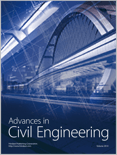
Advances in Civil Engineering
Exploring New Frontiers in Civil EngineeringAdvances in Civil Engineering is a leading peer-reviewed journal published by HINDAWI LTD, dedicated to advancing knowledge and innovation in the field of civil and structural engineering. Holding an esteemed Q2 ranking in the 2023 category for Civil and Structural Engineering, this journal serves as a vital platform for disseminating cutting-edge research and practical applications that address contemporary challenges in infrastructure development, sustainable design, and material science. Launched in 2008 and operating as an Open Access journal since 2009, it promotes the free exchange of ideas by ensuring that all articles are accessible to researchers, professionals, and students globally. The journal is also indexed in Scopus, ranking at #142 out of 379 in its category, situating it within the 62nd percentile of its peers. With a focus on interdisciplinary collaboration and innovative solutions, Advances in Civil Engineering contributes significantly to the ongoing evolution of engineering practices and education, making it an essential resource for anyone involved in or studying the ever-evolving field of civil engineering.

STEEL AND COMPOSITE STRUCTURES
Innovating Steel and Composite SolutionsSTEEL AND COMPOSITE STRUCTURES is a leading academic journal published by TECHNO-PRESS, dedicated to the fields of Building and Construction, Civil and Structural Engineering, and Materials Science. With a notable Impact Factor and classified in Q1 and Q2 quartiles in multiple relevant categories as of 2023, the journal provides a high-quality platform for the dissemination of innovative research from its converged publishing years of 2004 to 2024. The journal's rigorous peer-review process ensures that only the most impactful studies receive publication, fostering advancements in composite materials and steel structures. Researchers, professionals, and students alike can gain valuable insights into current technologies and applications in these critical fields, making STEEL AND COMPOSITE STRUCTURES an essential resource for anyone involved in structural engineering and materials research. The journal is based in South Korea, and while it offers traditional access options, the breadth of its contributions ensures a global reach and influence.

Revista Ingenieria de Construccion
Connecting Academics and Practitioners for Global ImpactRevista Ingenieria de Construccion is a prominent open-access journal dedicated to advancing knowledge and practice in the fields of building and construction engineering, as well as civil and structural engineering. Published by the Pontificia Universidad Católica de Chile, specifically the Department of Engineering and Construction Management, this journal has been providing free access to quality research outputs since 1986, ensuring that vital information is available to both practitioners and academics globally. With its current placement in the Q4 category of both the Building and Construction and Civil and Structural Engineering quartiles, it serves as a platform for innovative studies and critical discussions, positioning itself strategically within the academic landscape. The journal is indexed in Scopus, ranking #157 in Building and Construction and #291 in Civil and Structural Engineering, reflecting the growing impact and relevance of its contributions. Researchers, professionals, and students are encouraged to engage with the rigorous and diverse content published within its pages, fostering a vibrant academic and practical discourse.
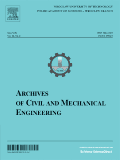
Archives of Civil and Mechanical Engineering
Unveiling Innovations for a Sustainable TomorrowArchives of Civil and Mechanical Engineering is a distinguished peer-reviewed journal published by SpringerNature, focusing on advancing the fields of civil and mechanical engineering. With an impressive Q1 ranking in both categories in 2023, this journal caters to a global audience, addressing the evolving challenges and innovations within these vital engineering disciplines. The journal has been a pivotal platform since its inception in 2006, and it continues to be essential for researchers and practitioners seeking to publish and access high-quality research. The absence of an Open Access option ensures that published works maintain rigorous academic standards, thereby enhancing their value within institutional repositories. With a robust impact factor and high visibility on Scopus—ranking #122 out of 672 in Mechanical Engineering and #74 out of 379 in Civil and Structural Engineering—this journal is an ideal venue for professionals, researchers, and students dedicated to advancing their knowledge and contributing to cutting-edge engineering practices. Based in Germany and operating internationally, the Archives of Civil and Mechanical Engineering invites submissions that address critical issues and solutions in contemporary engineering.

Electronic Journal of Structural Engineering
Transforming Ideas into Engineering ExcellenceThe Electronic Journal of Structural Engineering (ISSN: 1443-9255), published by EJSE INT LTD, serves as a vital platform for disseminating innovative research and developments in the field of structural engineering. Since its inception in 2001, the journal has evolved to embrace an Open Access model starting in 2022, ensuring that cutting-edge findings are freely accessible to researchers, professionals, and students worldwide. Housed within the reputable Department of Infrastructure Engineering at the University of Melbourne, Australia, the journal focuses on a wide range of topics related to civil and structural engineering, positioning itself within the Q4 category on the 2023 Scopus rankings. While its H-index and detailed scope data are currently unavailable, the journal's commitment to quality research is evident through its continuous publication and engagement with the global academic community. With significant implications for contemporary engineering practices, The Electronic Journal of Structural Engineering not only fosters scholarly discourse but also encourages practical applications of structural engineering advancements.